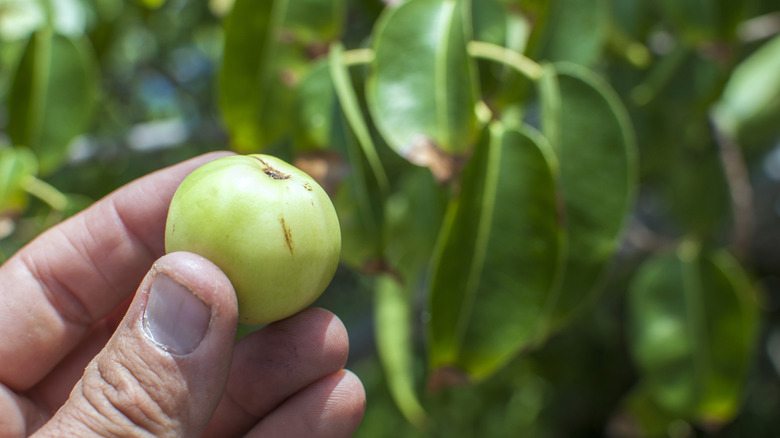If there’s anything we learned quickly as kids, it’s to never eat some of the wild berries that grow around us. Sure, those wild crab apples or buffaloberries that grow on your neighbor’s tree might look appetizing, but they can cause some serious tummy upset — and some can even be poisonous. So unless you’re like Westley in “The Princess Bride” who has spent years building up an immunity to poison, you should never eat what you find in the wild. There is one wild fruit that grows in Florida (in addition to Central America, South America and the Caribbean) that’s so toxic, it’s known as the “little apple of death.” What’s more, it’s not just the fruit — the tree itself can inflict serious injury and might prove fatal.
It’s called the manchineel tree, and the Guinness Book of World Records has bestowed it with an ominous title: The World’s Most Dangerous Tree. The word “manchineel” is an aberration of the Spanish phrase “manzanilla de la muerte” (aka, “little apple of death”) and first received its foreboding moniker when conquistadors in 1513 were attacked by the Indigenous Calusa people who dipped their arrows in the tree’s poisonous sap. So how does the fruit and sap cause so much damage? And how can you protect yourself from danger the next time you’re in Florida?
The manchineel tree can cause burns, blisters, and blindness

Just touching the bark of the manchineel tree can result in painful blisters at the point of contact. If you touch the bark and then rub your eyes, it can cause blindness. What’s worse, even being near the tree can result in injuries. If you’re underneath the tree while it’s raining, any rain droplets that bounce off the tree (sopping up the sap) and then land on your skin can also cause brutal, unrelenting blisters. If the tree is burning, merely inhaling the smoke can cause — you guessed it — blindness. If you come across any of the apples from the tree and take a bite, you can experience anything from a burnt mouth to oral blisters and gastroenteritis.
A National Institute of Health article written by radiologist Nicola Strickland explained her personal experience with the apple of death: “We noticed a strange peppery feeling in our mouths, which gradually progressed to a burning, tearing sensation and tightness of the throat […] we could barely swallow solid food because of the excruciating pain and the feeling of a huge obstructing pharyngeal lump.”
All of this comes down to the sap which contains a toxic compound known as phorbol, which is water soluble, hence its ability to harm you in a variety of ways. Luckily, there are ways to avoid getting sick and protect yourself.
Heed warning signs

It’s important to note that while exposure to this tree has proven fatal, HowStuffWorks points out that there haven’t been any recorded fatalities in modern times. In fact, one woman wrote about her experience of eating the little apple of death in 2022, and while she immediately experienced intense burning feelings in her mouth and a fever, her symptoms disappeared after about six hours. She did seek medical attention after a few hours of pain and was given the all-clear after a check-up.
There are ways to protect yourself. Most manchineel trees are clearly labeled as dangerous and toxic, so you’ll know not to get too close if you see one in the wild. If you do happen to accidentally touch a manchineel tree or eat the apple, you will experience the worst of the symptoms immediately, so you’ll know right away that you’re injured. And that knowledge might save your life. Seek medical attention ASAP so you can receive immediate treatment.

